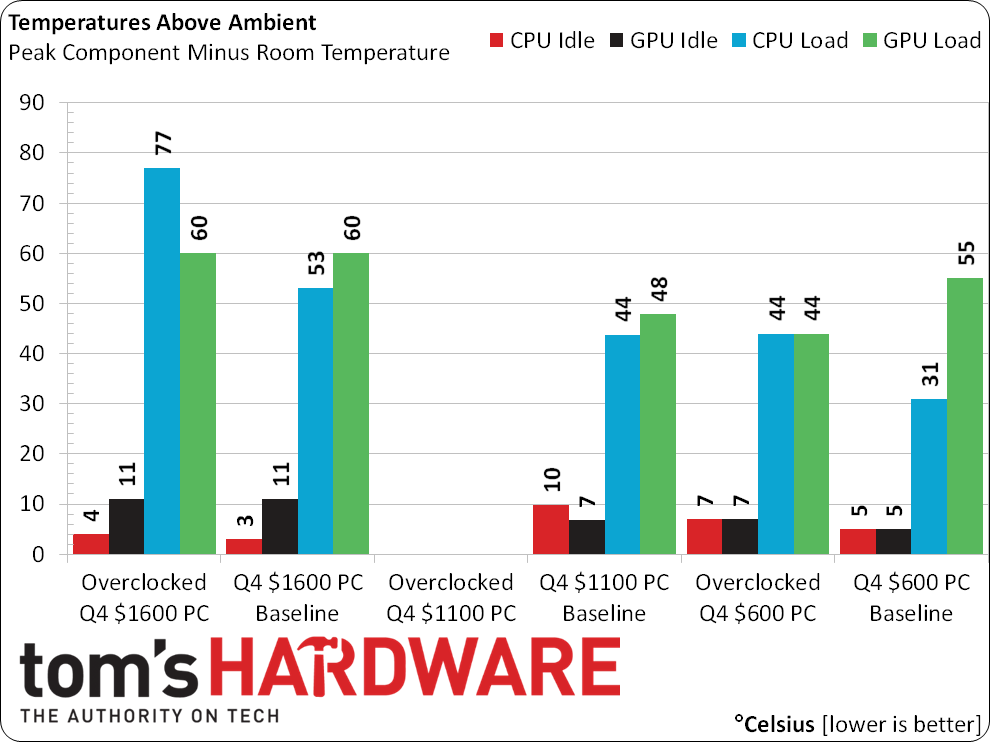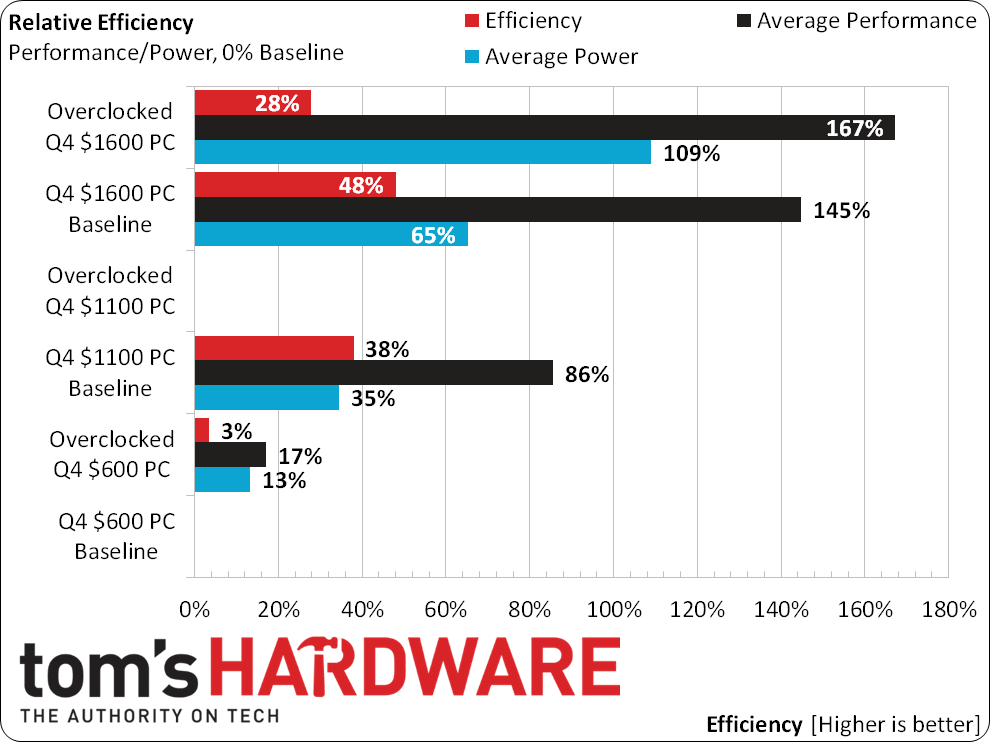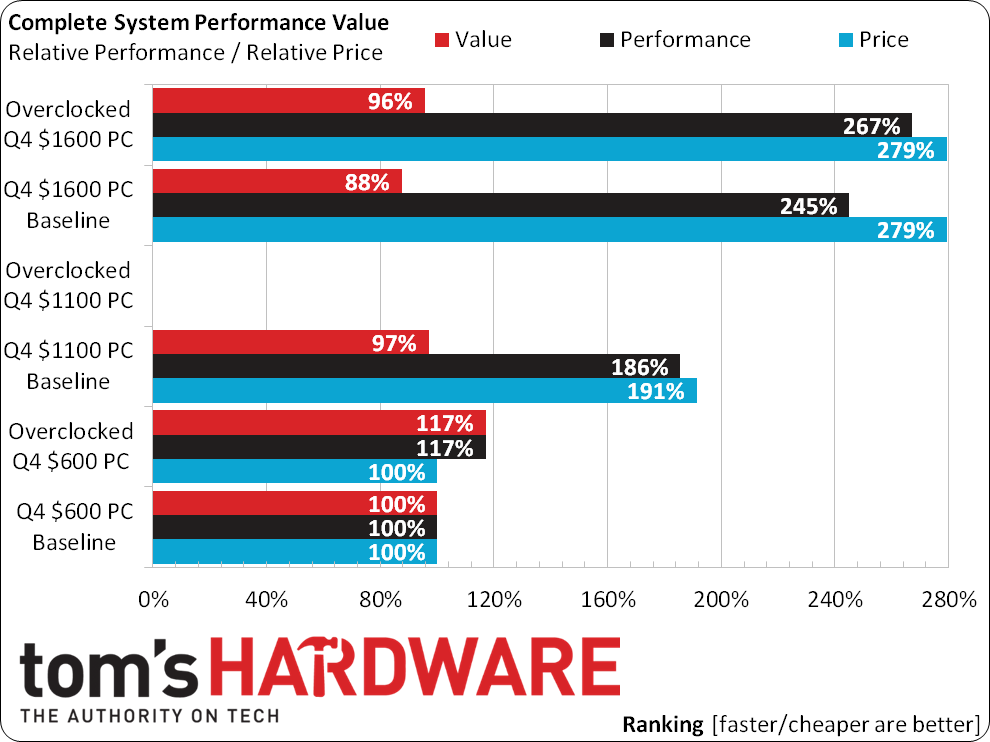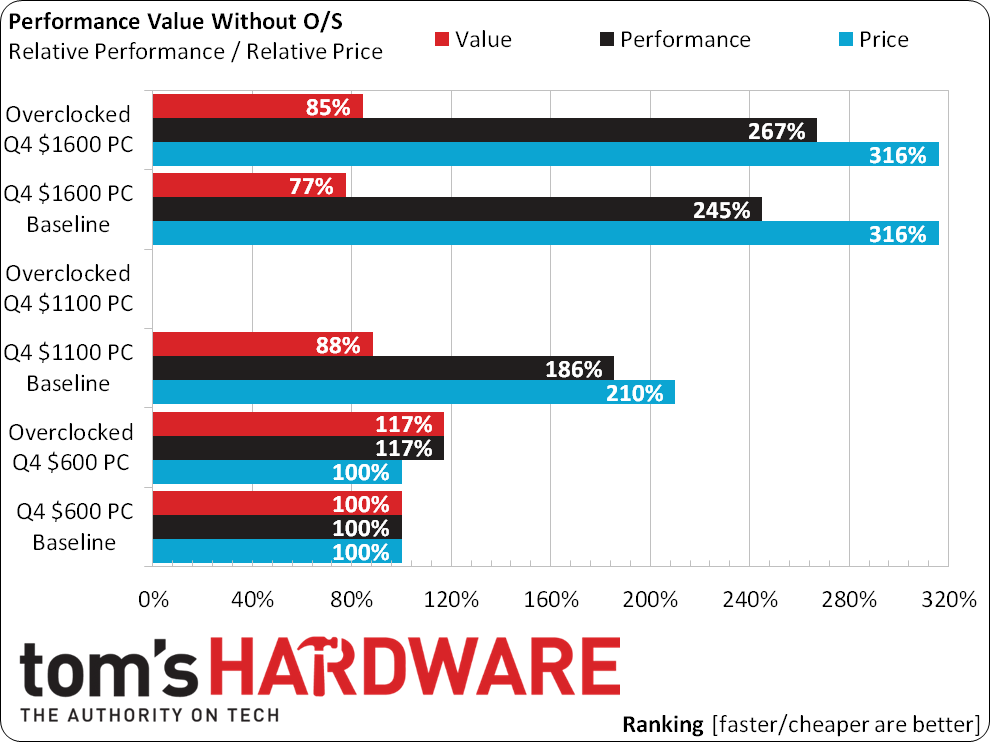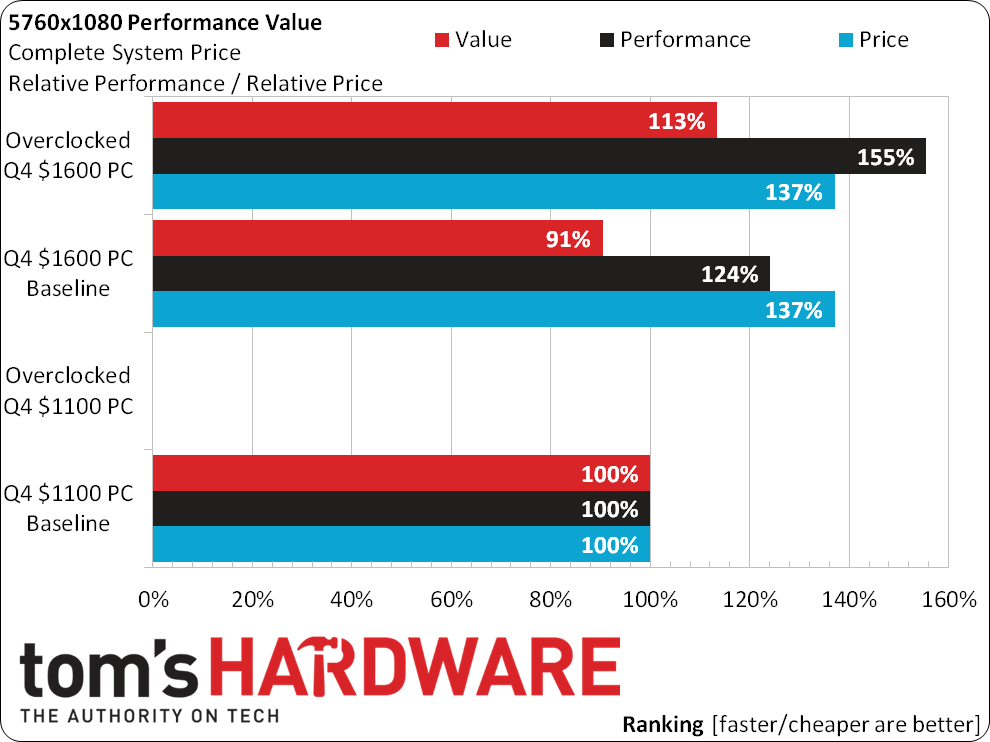System Builder Marathon Q4 2014: Value Compared
Power, Heat, Efficiency And Value
More hardware generally requires more power, even when comparing two graphics cards with different configurations of the same GPU. In the case of the $1600 PC’s CPU, it gets a double-whammy in energy consumption by having both higher clocks (at higher voltage) and higher full-load core utilization, thanks to Intel's Hyper-Threading technology.
An efficient power supply helped when comparing the current $1600 PC to my previous $1600 build. But this quarter's setup still looks like a power hog compared to the other two machines. Don’s $1100 PC even appears fairly miserly, considering that its rather small increase in power consumption yields a big performance advantage over Paul’s $600 machine.
Don’s $1100 machine also runs fairly cool by quad-core standards.
My machine needs to perform nearly three times as well as Paul’s to be worth nearly three times the price. It gets close enough in Productivity and File Compression, but falls short in other places. Don’s $1100 machine looks like a more realistic value contender.
Using Paul’s $600 PC as a baseline, we can see that he gained 17% in performance while increasing power consumption by only 13%, for a 3% efficiency increase via overclocking. Don’s machine is 38% more efficient than Paul’s baseline, and my $1600 build started out 48% more efficient. My efficiency drops significantly during the overclock, though, falling behind Don’s baseline.
This is where things get interesting. I had to overclock to approach the value rating of Paul’s $600 baseline. Unable to overclock, Don settles for a similar score. Meanwhile, Paul uses the Pentium G3258’s unlocked status to boost the value of his own machine by 17%.
The operating system is a large portion of Paul’s complete system price, so his value score climbs quickly when that cost is removed. As someone who never pays full price for software, I approve of his gain in spite of my loss.
Get Tom's Hardware's best news and in-depth reviews, straight to your inbox.
Reducing the hardware set to only the parts needed for benchmarking, Don’s $1100 PC climbs back into a competitive position. Overclocking could have put him over the top, if not for his configuration woes.
I’m finally able to top a value chart by excelling in high-end gaming, and only because Don couldn’t overclock. My graphics card scaled quite well, and I believe he could have matched me had it not been for failures in other parts of his system.
As usual, Paul wins every value metric except the one that he didn’t compete for: gaming at 5760x1080. Don is stuck in second place throughout, which is particularly stinging when we consider that his machine should have been more overclockable than Paul’s.
My $1600 machine wins one value metric in high-resolution games, and I’m afraid that if I want to stay competitive without dropping into Don’s price class, I might have to spend more on graphics in our next SBM. Rather than a single GeForce GTX 980, perhaps a pair of 970s would work. It’s only an extra $40, and I’ve never seriously considered tapping into the $200 I leave in reserve.
And that leads me to a final confession: I built my system to provide room for an eventual SLI upgrade, without checking to see that the motherboard I used is blacklisted by Nvidia’s SLI compatibility detection. Even though the requisite components are there, the manufacturer chose not to pay Nvidia to have this motherboard certified. I could have saved money by pairing the non-SLI motherboard with a smaller power supply, but I didn’t. And next time, that caution will force me to pay more for a motherboard that Nvidia supports.
Conversely, Paul doesn’t appear to have any room to lower his budget and stay competitive. His Radeon R9 270X graphics card presents an almost ideal price/performance balance, and his low-end Pentium CPU is unlocked for excellent overclocking capability. His value win is not merely an indication of the machine’s lower cost, but is instead a tribute to his excellent choice of components.
-
g-unit1111 I was personally not a fan of the drab, bueraucrat approved case choices but overall these are some sweet rigs. I actually bought the MSI H81 / Pentium G3258 combo for my HTPC based off the recommendations here and have been really pleased with the results so far.Reply -
Crashman Reply
AMD is over-represented in SBMs, with over 2/3 of prior graphics cards being Radeons and even one of the cards in this one being an R9 270X.14927184 said:I have little desire to read when no AMD CPU is involved
You should print that statement on foil before making your next hat :)
-
Onus I hope Don is able to figure out what went wrong, then update his results with some kind of overclocking results. He did say he would try...Reply
-
rayden54 A couple questions: I've heard that there are some new games that don't work at all on dual core processors including the famed Pentium G3258. Have you encountered this issue and would it effect your recommendations if it's true?Reply -
Bannereus Tough break for Don ... too bad this one couldn't be solved with a hacksaw xDReply
If overclocking wasn't part of the competition, the $1100 rig would have been the closest to beating the value of the budget entry that I've seen in a while.
I'm really glad to see that efficiency and value are coming to the higher-performance market (even without overclocking savy). -
MasterMace If you're looking for value performance you can't use a card over $250, you have to SLI/XF 2 - 200-250 cards. But people aren't looking for that as frequently as it adds the cost of a much bigger power draw.Reply
I'm still hoping for a build that dual-sockets to get rid of the CPU bottleneck. -
g-unit1111 Reply14928639 said:A couple questions: I've heard that there are some new games that don't work at all on dual core processors including the famed Pentium G3258. Have you encountered this issue and would it effect your recommendations if it's true?
The Pentium G3258 is a good processor, and people like it because it's a cheap overclock friendly solution where the low end Intel i3s are not. But as an owner of one, for gaming it really has no practical usage. The system that I use mine in is mainly a media playback machine.


